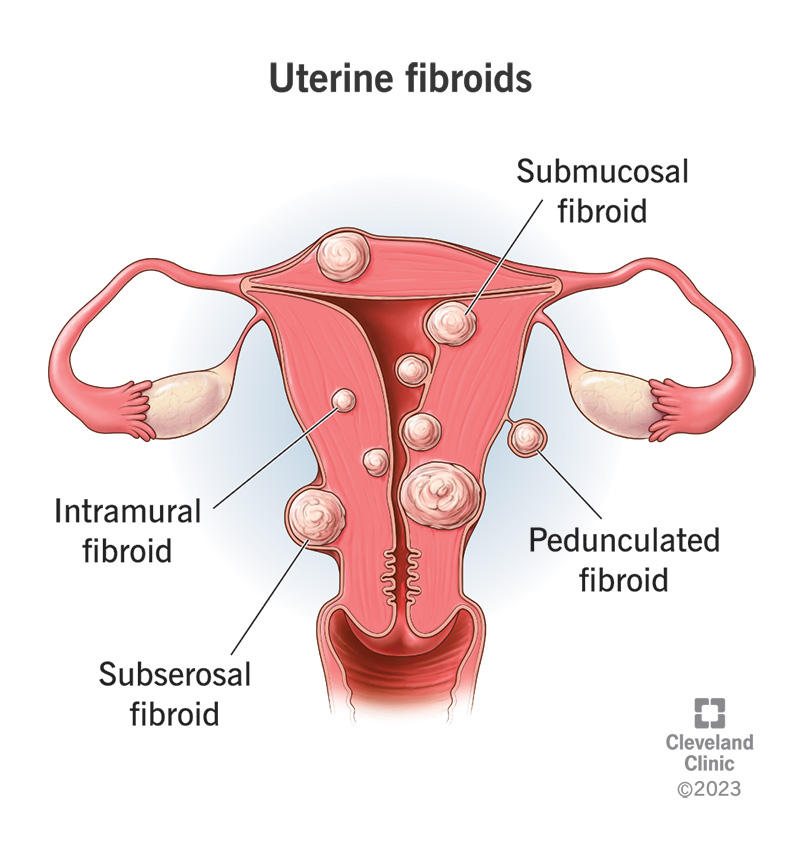
Fibroid uterus
Uterine fibroids (also known as leiomyomas) are muscle and tissue growths that occur in or on the uterine wall. These growths are the most prevalent noncancerous tumor in women and individuals assigned female at birth (AFAB) and they are typically not malignant (benign).
Overview
Other names for fibroids include the following: uterine fibroids fibromas myomas uterine myomas leiomyomas. However, the majority of people may never be aware that they have fibroids because they don't exhibit any symptoms. Fibroids can form in clusters or as a single nodule or solitary growth. Fibroid clusters can vary in diameter from 1 millimeter to over 20 centimeters (8 inches) or even greater. In contrast, fibroids can range in size from a seed's size to that of a watermelon. The development of these growths may occur on the exterior of your uterus inside its main cavity or within its wall.
Types: Fibroids are classified into several categories. Depending on where they are in the uterus or inside it the types vary.
1. Intramural fibroids: are the most frequent form of fibroids. They emerge from within the uterine muscle wall. Larger intramural fibroids have the potential to strain your uterus.
2. Subserosal fibroids: Subserosal fibroids develop on the serosa the outer layer of your uterus. They could get big enough to give the impression that your uterus is larger on one side.
3. Pedunculated fibroids: A stem or thin base supporting the tumor can form in subserosal fibroids. They are referred to as pedunculated fibroids when that occurs.
4. Submucosal fibroids: These tumors grow in the middle layer of your uterus called the myometrium. Tumors of the submucosa are less prevalent than other kinds.
5. Cervical fibroids: Cervical fibroids develop on the cervix which connects the uterus to the vagina. They’re also rare.
Causes
The cause of fibroids is unknown. Several variables could impact its development:
Hormones: Progesterone and estrogen are produced by the ovaries. These hormones promote the formation of fibroids and cause the uterine lining to renew with each menstrual cycle.
Family background: A family history of fibroids is possible. You could have this illness if your grandmother mother or sibling had it in the past.
Individuals who have one or more of the following risk factors are more likely to develop fibroids: a family history of fibroids 30 years old or older a high body weight.
Symptoms
The number location and size of the tumors you have will affect your symptoms. Submucosal fibroids, for example, might lead to severe monthly flow and difficulty getting pregnant. You might not experience any symptoms if your tumor is very small or if you are going through menopause. Even after menopause and throughout menopause fibroids may diminish. This is due to the decline in progesterone and estrogen levels that occurs after menopause. These hormones promote the formation of fibroids. Symptoms of fibroids may include:
Heavy bleeding between or during your periods
Menstrual clots
Menstruation that lasts longer than usual
Increased menstrual cramping
Pain in the pelvis and lower back
Pressure or fullness in your lower abdomen
Swelling or enlargement of the abdomen
Increased urination
Pain during intercourse.
Ayurvedic View
Garbhashaya gata granthi- here all the three doshas are involved, namely vata, pitta and kapha dosha, these prakupita (aggravated) dosha does vitiation of rakta (blood), mamsa (muscle), meda (fat layer) causes a round protuberance, that is hard and it does not undergo paak (suppuration), this disease is fibroid which affects uterus. Ayurveda way of approach is to correct agni (metabolism) and reduce symptoms by ayurvedic panchakarma treatment.
Ayurvedic Treatments
Lepanam Uttaravasti Virechanam Dhoopanam
Naturopathy Treatments
Hip bath Spinal spray Immersion bath Enema Steam bath Sun bath Mud therapy Pelvic Packs Reflexology Acupuncture Manipulative therapy Diet therapy Clinical yoga Pranayama Kriyas
Fibroid uterus
Treatment for
DISCLAIMER: Listed treatment details are only for information purposes. Treatments and duration may vary depending on numerous factors. Treatments for your condition may not be limited to this list.






















